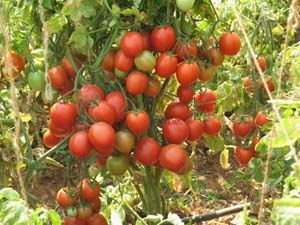Cultural Practices
Land preparation
Good land preparation is essential to express the potential of the crop. This can be achieved by cultivation to a depth of 30-45cm by ploughing/chiesling, clod crushing, and rotavating. Before the final land preparation, about 25 tons/ha well decomposed, bioagent inoculated FYM need to be mixed to the soil. After bringing the soil into fine tilth, layout the land into raised bed system by making a bed of 80cm and furrow of 40cm. Broad bed system of cultivation facilitates the adoption of improved technologies like drip irrigation, fertigation, and polyethylene mulching. In the normal method, furrows are opened at a spacing of 105cm to 120cm for hybrids.
Use of bio agents
Trichoderma an useful antagonistic fungi is to be mixed to FYM @ 1kg/tonne and allowed to multiply with proper moisture in it for 15 days. Similarly Azospirillum/Azatobactor and PSB also need to be mixed to the FYM simultaneously. This bioagent inoculated FYM need to be mixed with remaining FYM and applied to main field just before final land preparation. These bioagents also need to be applied to the growing media during nursery preparation @ 1kg/tonne of media.
Nursery raising and seed rate:
Seedling raising using seedling tray and cocopeat as media in a protected structure such as nethouse is the order of the day. This ensures quality seedlings with less viral disease infection to the seedlings. Many enterprising farmers started vegetable nursery business in the intensively vegetable growing area and farmer can directly buy seedlings from this seedling unit. However, individual farmers can also raise seedling in this improved method. A net cage made of 40-mesh nylon cloth, steam sterilized cocopeat and 98-celled seedling trays need to be procured by the farmer. To produce 10000 seedlings, a net cage of the size 7.5m length, 3.4m width and 2.4m height is to be made. Systemic insecticide need to be sprayed before transplanting to the seedling in the tray. Similarly fungicides like COC @ 3g/L need to be drenched to the seedlings to prevent the soil borne disease immediately after transplanting. About 75g seed is required to plant one hectare of tomato at a spacing of 120cmx45cm (about 18000 plants/ha) in portray method. The seed rate per hectare for hybrids in raised bed method is 100-125g and for OP varieties is 200-250g. Seedlings will be ready for transplanting after 20-25 days of sowing.
Transplanting
In the raised bed method of planting, 25 day old hardened and stocky seedling are planted in the center of the bed at a pacing of 45 cm from plant to plant. Controlled irrigation is to be provided till one week to minimize the seedling mortality soon after transplanting. In the normal method of transplanting, furrows are opened at 105-120cm for hybrids and seedlings are transplanted at a spacing of 30-45 cm in a furrow.
Drip irrigation
Adoption of drip irrigation and fertigation in tomato is beneficial in much way in tomato cultivation. A head control unit having pump, disc filter, fertilizer injecting ventury or tank or pump, pressure gauge and air release valve are necessary. Inline drip lateral are taken out from the PVC pipe at a distance of 1.2meters. These inline drip lateral with an emitting spacing of 40cm having discharge rate of 3-4 liters/hour is selected. Daily drip irrigation is to be followed based on the stage of the crop (crop factor) and daily evaporation. The crop factor varies between 0.3 during establishment to 0.80-0.85 during peak growth and flowering period at about 50 to 60 days after transplanting. It is advisable to check the water quality parameters such as EC before the installation of drip irrigation.
Fertilizers and Fertigation
The fertilizer recommendation for a hybrid tomato is 180:120:150kg NPK/ha. In a fertigation schedule, to save the cost on fertilizers, entire P fertilizer can be applied through soil at the time of planting as single super phosphate. Nitrogen can be injected as urea and for potash, water soluble potassium nitrate can be used. For injecting the fertilizer, ventury or fertilizer tank or fertilizer injector can be adopted. Fertigation can be commenced 10 days after transplanting and continued on a daily basis or bi-weekly interval. Fertigation can be stopped three weeks before the final harvest.
In normal soil application method of fertilization to hybrids, 1/3rd Nitrogen, full phosphorus and 1/3rd potash is applied before transplanting as basal dose. At 4 weeks after transplanting 1/3rd nitrogen and 1/3rd potash need to be side dressed. Remaining 1/3rd nitrogen and 1/3rd potash need to be side dressed 8-9 weeks after transplanting. For open pollinated varieties the recommended doses of fertilizer is 120:100:60kg NPK/ha. Half the dose of nitrogen is applied as basal dose and remaining half is given after 4 weeks of transplanting. Entire phosphorus and potash is applied as basal dose before transplanting.
Inter-cultivation, staking and weeding
Arrangement for staking the tomato plants is to be made by using bamboo, casurina or eucalyptus sticks and GI wire. Staking helps in better plant protection, easy harvesting and finally improves the yield and quality. In the ridges and furrow method of planting, earthing up and side dressing of nitrogen fertilizers is done 4 weeks after transplanting. The plots should be kept weed free up to 45 days after transplanting.
Mulching
Polyethylene mulch of 30 micron thickness with silver-black colour surface is to be used. For beds of 80 cm width, 90m wide polyethylene mulch film need to be covered by tightly stretching the film and securing the edges o the sheet by burying in the soil.
Foliar nutrition
The crop is sprayed with micronutrient formulation (3-5g/litre) 2-3 times once in 10-15 days starting from 45days after transplanting, and depending on the symptom of deficiency. If calcium deficiency is expected, chelated form of Calcium need to be given as foliar nutrition. Foliar nutrition of 19-19-19 with micronutrient or potassium sulfate or potassium nitrate (5g/litre) during fruit development stage will enhance the fruit size, colour and quality.
